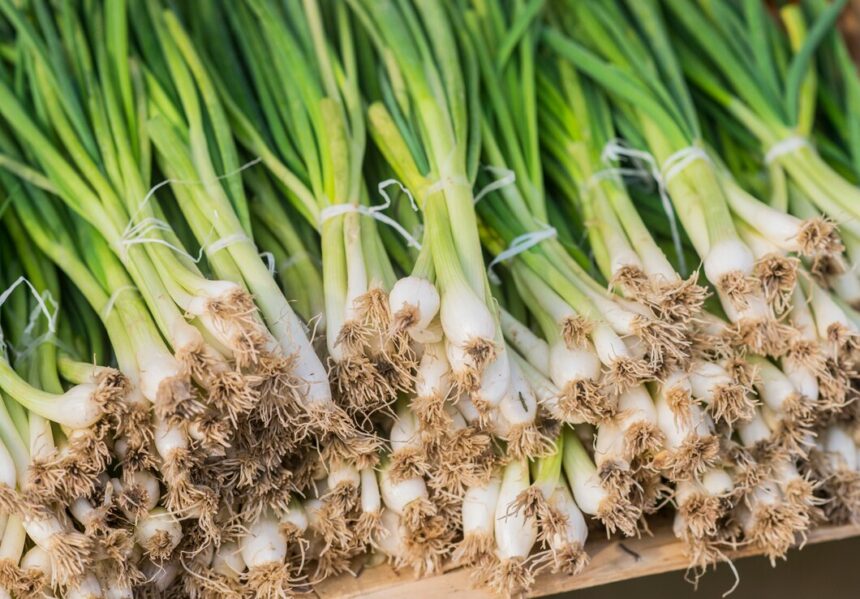Scallions, also known as green onions or spring onions, are a versatile and popular vegetable that can be easily grown in South Africa. They require minimal space and are suitable for both small and large-scale farming. This article provides detailed information on the process of growing scallions from seed to harvest, including land preparation, growth stages, inputs, disease management, and storage.
1. Land Preparation
Soil Requirements:
Scallions thrive in well-drained, fertile soils rich in organic matter. The ideal soil types include sandy loam or loamy soils with a pH of 6.0 to 6.8. Conduct a soil test to assess nutrient levels and pH balance.
Preparation Steps:
- Tilling: Prepare the soil by tilling it to a depth of about 15-20 cm to aerate and break up any compacted soil.
- Weed Control: Remove any weeds from the planting area to reduce competition for nutrients and water.
- Soil Amendment: Incorporate organic matter, such as well-rotted compost or manure, to improve soil fertility and structure.
2. Seed Selection and Sowing
Seed Selection:
Choose high-quality scallion seeds from reputable suppliers. Varieties like ‘Evergreen Hardy’ and ‘Tokyo Long White’ are popular choices in South Africa.
Sowing Process:
- Timing: Sow scallion seeds in early spring or late summer for optimal growth.
- Spacing: Sow seeds about 1-2 cm apart and 0.5 cm deep in rows spaced 30 cm apart.
- Transplanting: If starting seeds indoors, transplant seedlings when they are 10-15 cm tall and have at least two true leaves.
3. Watering Requirements
Watering Needs:
Scallions require consistent moisture for optimal growth. The soil should be kept moist but not waterlogged.
Frequency:
- Water the plants regularly, especially during dry spells. Aim for about 2.5 cm of water per week, adjusting based on rainfall.
- Use drip irrigation or soaker hoses to minimize water waste and avoid wetting the foliage, which can lead to diseases.
4. Fertilization
Types of Fertilizers:
- Organic Fertilizers: Use well-composted manure or fish emulsion to provide a slow-release source of nutrients.
- Synthetic Fertilizers: A balanced fertilizer (NPK 10-10-10) can be applied at planting, followed by side-dressing with a nitrogen-rich fertilizer (like urea) when the plants are about 15 cm tall.
Application:
- Apply fertilizers according to soil test results, usually at the time of sowing and again mid-growth to support vigorous leaf development.
5. Growth Stages
Scallions typically go through several growth stages:
- Germination (Days 7-14): Seeds will sprout within 7-14 days under optimal conditions. Maintain moisture during this period.
- Seedling Stage (Weeks 2-4): Once seedlings emerge, ensure adequate sunlight (at least 6 hours a day) and continue consistent watering. Thin seedlings to prevent overcrowding, leaving 5-10 cm between plants.
- Vegetative Growth (Weeks 4-8): The plants will develop tall green leaves during this phase. Monitor for pest and disease signs and apply fertilizers as needed.
- Maturation (Weeks 8-12): Scallions are ready for harvest when the stalks are firm, and the leaves are vibrant green, typically 10-12 weeks after sowing.
6. Pest and Disease Management
Common Pests:
- Aphids: Small, green insects that suck sap from leaves. Use insecticidal soap or neem oil for control.
- Thrips: Tiny, slender insects that can cause silver streaks on leaves. Regular scouting and the introduction of beneficial insects can help manage thrip populations.
Diseases:
- Downy Mildew: A fungal disease causing yellowing leaves and white spores on the underside. Use resistant varieties and ensure good air circulation.
- Fusarium Wilt: This soil-borne fungus causes wilting and yellowing. Rotate crops and avoid planting in infested soil.
Pesticide and Herbicide Use:
- Apply pesticides only when pest thresholds are met. Use selective insecticides to minimize harm to beneficial insects.
- Herbicides can be used for weed control but should be applied carefully to avoid damaging scallion plants. Pre-emergent herbicides can prevent weed germination, while post-emergent options target existing weeds.
7. Harvesting Scallions
Harvest Timing:
Scallions can be harvested when they reach about 15-20 cm in height. For optimal flavor, harvest before the plants flower.
Harvesting Method:
- Use a sharp knife or shears to cut the scallions at the soil level.
- Handle them carefully to avoid bruising.
8. Post-Harvest Handling and Storage
Cleaning:
Gently rinse scallions in cool water to remove soil and debris. Avoid excessive handling to prevent damage.
Storage:
- Store scallions in a cool, dry place or in the refrigerator. They can be kept in a perforated plastic bag to maintain moisture while preventing rot.
- For longer storage, consider drying or freezing scallions.
Growing scallions from seed to harvest requires careful planning and management, but the rewards can be significant. By understanding the necessary inputs, growth stages, and potential challenges, South African farmers can successfully cultivate scallions and enjoy a bountiful harvest. Regular monitoring and timely interventions are key to maintaining healthy crops and ensuring profitability in this popular vegetable market.
Join 'Farmers Mag' WhatsApp Channel
Get the latest Farming news and tips delivered straight to your WhatsApp
CLICK HERE TO JOIN






